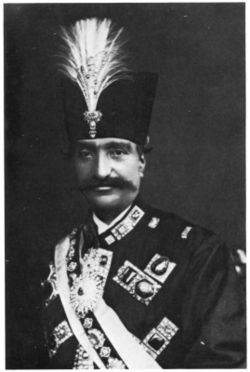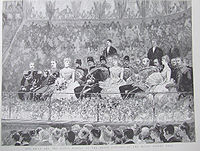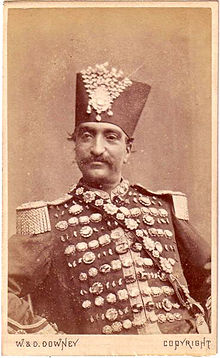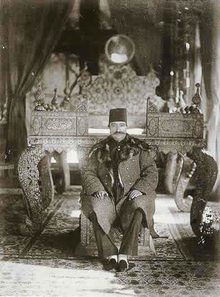- Naser al-Din Shah Qajar
-
 Naser al-Din Shah Qajar
Naser al-Din Shah QajarShahanshah of Iran 
Reign 1848–1896 Full Name Nasser al-Din Shah Born 16 July 1831 Birthplace Tabriz, Persia Died 1 May 1896 (aged 64) Place of death Tehran, Persia Predecessor Mohammad Shah Qajar Successor Mozaffar ad-Din Shah Qajar Dynasty Qajar Dynasty Religious beliefs Shia Islam Nasser al-Din Shah Qajar [1] (July 16, 1831 – May 1, 1896) (Persian: ناصرالدین شاه قاجار Nāṣiru d-Dīn Shāh Qājār) was the King of Iran from September 17, 1848 to May 1, 1896 when he was assassinated. He was the son of Mohammad Shah Qajar and Malek Jahan Khanom, Mahd-e Olia and the third longest reigning monarch king in Iranian history after Shapur II of the Sassanid Dynasty and Tahmasp I of the Safavid Dynasty. He had sovereign power for close to 50 years and was also the first Persian monarch to ever write and publish his diaries.
Contents
Biography
He was in Tabriz when he heard of his father's death in 1848, and he ascended to the Peacock Throne with the help of Amir Kabir.
Though Naser al-Din had early reformist tendencies, he was dictatorial in his style of government. Unprovoked, he persecuted small numbers of Bábís and Bahá'ís, thinking they were heretics. Under his sanction, as many as two thousand Bábí's (often armed) including a few women and children, were brutally murdered. This persecution increased when a Bábí, seeking revenge for the death of the Bab, attempted to assassinate him in 1852.[2] This treatment continued under his Prime Minister Amir Kabir, who even ordered the execution of The Báb - regarded as a Manifestation of God to Bábí's and Bahá'ís, and to historians as the founder of the Bábí religion.
Unable to regain territory lost to Russia in the early 19th century, Nāṣer al-Dīn sought compensation by seizing Herāt, Afghanistan, in 1856. Great Britain regarded the move as a threat to British India and declared war on Iran, forcing the return of Herāt as well as Iranian recognition of the kingdom of Afghanistan. [3]
He was the first modern Iranian monarch to visit Europe in 1873 and then again in 1878 (when he saw a Royal Navy Fleet Review), and finally in 1889 and was reportedly amazed with the technology he saw there. During his visit to the United Kingdom in 1873, Naser al-Din Shah was appointed by Queen Victoria a Knight of the Order of the Garter, the highest English order of chivalry. He was the first Iranian monarch to be so honoured. His travel diary of his 1873 trip has been published in several languages as Persian, German, French and Dutch.
During his visit, Naser al-Din met with British Jewish leaders, including Sir Moses Montefiore. At that time, the Persian king suggested that the Jews buy land and establish a state for the Jewish people.[4]
In 1890 he met British Gerald Talbot and signed a contract with him giving him the ownership of Iranian Tobacco Industry, but he later was forced to cancel the contract after Ayatollah Mirza Hassan Shirazi issued a Fatwa that made farming, trading and consuming tobacco as Haram (forbidden). It even affected the Shah's personal life as his wives did not allow him to smoke.
This was not the end of his attempts to give advantages to Europe; he later gave the ownership of Iranian Customs incomes to Paul Julius Reuter.
Naser al-Din was effective in introducing several different western influences to Iran. He curbed the secular power of the clergy, introduced telegraph and postal services, built roads, opened the first school offering education along Western lines, and launched Iran's first newspaper. He was the first Iranian to be photographed and was a patron of photography who had himself photographed hundreds of times. His final prime minister was Ali Asghar Khan, who after the shah's assassination aided in securing the transfer of the throne to Mozaffar al-Din.
 The Shah, on his European tour, in the Royal Albert Hall, London. Seated between the Princess of Wales and her sister, the Tsesarevna of Russia
The Shah, on his European tour, in the Royal Albert Hall, London. Seated between the Princess of Wales and her sister, the Tsesarevna of Russia
In the later years of his rule, however, he steadfastly refused to deal with the growing pressures for reforms. He also granted a series of concessionary rights to foreigners in return for large payments that went into his own pockets. In 1872 popular pressure forced him to withdraw one concession involving permission to construct such complexes as railways and irrigation works throughout Iran. In 1890 he made an even greater error in granting a 50-year concession on the purchase, sale, and processing of all tobacco in the country, which led to a national boycott of tobacco and the withdrawal of the concession. This last incident is considered by many authorities to be the origin of modern Iranian nationalism.
Naser al-Din was assassinated by Mirza Reza Kermani, a follower of Jamal al-Din al-Afghani, when he was visiting and praying in the shrine of Shah-Abdol-Azim. It is said that the revolver used to assassinate him was old and rusty, and had he worn a thicker overcoat, or been shot from a longer range, he would have survived the attempt on his life.[5] Shortly before his death he is reported to have said "I will rule you differently if I survive!" Naser al-Din Shah's assassin was prosecuted by the Defence Minister Nazm ol Doleh.
He was buried in the Shah-Abdol-Azim Cemetery, in Rayy near Tehran, where he was assassinated. His one-piece marble tombstone, bearing his full effigy, is now kept in the Golestan Palace Museum in Tehran and is renowned as a masterpiece of Qajar-era sculpture.
Artistic and literary interests
 DThe Shah in a uniform studded with diamonds from the treasury of the Persian emperors. Often he wore the famous square Darya-ye Noor
DThe Shah in a uniform studded with diamonds from the treasury of the Persian emperors. Often he wore the famous square Darya-ye Noor
Naser al-Din Shah was very interested in painting and photography. He was a talented painter, and even though he had not been trained, was an expert in pen and ink drawing. Several of his pen and ink drawings survive. He was one of the first photographers in Persia and was a patron of that art. He established a photography studio in Golestan Palace.[6]
Naser al-Din was also a poet. 200 couplets of his were recorded in the preface of Majma'ul Fusahā, a work by Reza-Qoli Khan Hedayat about poets of the Qajar period. He was interested in history and geography and had many books on these topics in his library. He also knew French and English, but was not fluent in either tongue.[7]
Hekāyāt Pir Va Javān ("The Tale of the Old and the Young") was attributed to him by many; it was one of the first Persian stories written in modern European style.[8]
Honours
- Knight of the Order of the White Eagle of Russia-1838
- Grand Cross of the Legion d'Honneur of France-1855
- Grand Cross of the Order of St Stephen of Hungary-1859
- Grand Cross of the Order of Saints Maurice and Lazarus of Italy-1862
- Knight of the Order of the Most Holy Annunciation of Italy-1862
- Grand Cross of the Order of the Netherlands Lion-1868
- Knight of the Order of St. Andrew of Russia-1873
- Knight of the Order of St. Alexander Nevsky of Russia-1873
- Knight of the Order of Saint Stanislaus, 1st Class of Russia-1873
- Knight of the Order of St. Anna, 1st Class of Russia-1873
- Knight of the Order of the Garter (KG)-1873
- Knight of the Order of the Black Eagle of Prussia-1873
- Grand Cross of the Order of the Red Eagle of Prussia-1873
- Grand Cordon of the Order of Leopold of Belgium-1873
- Exalted Order of Honour of Turkey-1880
Offspring
Sons
- Prince Soltan Mahmoud Mirza (1847–1849) Vali Ahad of Persia, 1849
- Prince Soltan Moin al-Din Mirza (1849 – 6 November 1856) Vali Ahad of Persia, 1849–56
- Prince Soltan Mass'oud Mirza Zell-e Soltan (5 January 1850–2 July 1918)
- Prince Mohammad Qassem Mirza (1850 – 29 June 1858) Vali Ahad of Persia, 1856-8
- Prince Soltan Hossein Mirza Jalal ed-Dowleh (1852–1868) [9]
- Prince Mozaffar al-Din Shah (25 March 1853–7 January 1907)
- Prince Kamran Mirza Nayeb es-Saltaneh (22 July 1856 – 1927)
- Prince Nosrat al-Din Mirza Salar es-Saltaneh (2 May 1882 – 1954)
- Prince Mohammad Reza Mirza Rokn es-Saltaneh (30 January 1884 – 8 July 1951)
- Prince Hussein Ali Mirza Yamin ed-Dowleh (1890–1952)
- Prince Ahmad Mirza Azd es-Saltaneh (1891–1939)
Daughters
- Princess Afsar ed-Dowleh
- Princess Fakhr-ol-Moluk (1847 - 9 April 1878)
- Princess Esmat ed-Dowleh (1855 – 3 September 1905)
- Princess Zi'a es-Saltaneh (1856 - 11 April 1898) [10]
- Princess Fakhr ed-Dowleh (1859–1891)
- Princess Forugh ed-Dowleh (1862–1916)
- Princess Eftekhar es-Saltaneh (1880–1941)
- Princess Farah es-Saltaneh (1882 - 17 April 1899)
- Princess Tadj es-Saltaneh (1883 – 25 January 1936)
- Princess Ezz es-Saltaneh (1888–1982)[11]
Fictional depictions
- Naser al-Din Shah is depicted in the movie Nassereddin Shah, Actor-e Cinema (Once Upon a Time, Cinema) 1992 written and directed by Mohsen Makhmalbaf.
- He is the main character of the short story De koning 2002 and the novel De koning 2011 and by the Persian–Dutch writer Kader Abdolah.
Notes
- ^ Nasser al-Din is pronounced as Nāser-ad'din, and less formally as Nāser-ed'din.
- ^ Abbas Amanat. Pivot of the universe: Nasir al-Din Shah Qajar and the Iranian Monarchy, p. 204-218.
- ^ Article from Encyclopædia Britannica [1]
- ^ World Jewish Congress
- ^ Mo'ayeri p.105
- ^ Tahmasbpoor, Mohammad-Reza (2008). Nāser-od-din, the Photographer King. Tehran: Nashr-e Tarikh-e Iran. ISBN 964-6082-16-5
- ^ Mo'ayeri p.30
- ^ Mansuri, Kurosh(2006). Hekāyāte Pir Va Javān. Tehran: Motale'at Tarikh. ISBN 964-6357-69-5
- ^ Children of Naser al-Din Shah
- ^ Zi'a es-Saltaneh married Seyed Zeyn-ol-Abedin Emam Jome'eh. Her daughter, Zia Ashraf Emami married Mohammad Mosaddegh
- ^ Mo'ayeri pp.16-17
See also
- Qajar dynasty
- Order of Aftab
- Qajar art
- Tobacco Protest
- Persian Cossack Brigade
- Samad Khan Momtaz os-Saltaneh
- Marjane Satrapi
References
- Amanat, Abbas (2004). Pivot of the universe. Tehran: Karnameh. ISBN 964-431-049-7.
- Clay, Catrine (2006). King, Kaiser, Tsar. London: John Murray. ISBN 13-978-0-7195-6536-7.
- Mo'ayeri, Dustali (1982). Some notes from private life of Nasser al-Din Shah. Tehran: Nashr-e Tarikh-e Iran.
External links
- Nasser-al-Din Shah's Portrait
- Nasseredin Shah and his 84 wives
- His visit to England(select from list)
- Side view of Nasser-al-Din Shah's marble tombstone
- Window on an Era: A Qajar Royal Album. Selected photographs from a private album of Nasser al-Din Shah, with an introduction by Kaveh Golestan, Kargah
- Mohammad-Reza Tahmasbpoor, History of Iranian Photography: Early Photography in Iran, Iranian Artists' site, Kargah
- History of Iranian Photography. Postcards in Qajar Period, photographs provided by Bahman Jalali, Iranian Artists' site, Kargah.
- History of Iranian Photography. Women as Photography Model: Qajar Period, photographs provided by Bahman Jalali, Iranian Artists' site, Kargah.
- Sir James William Redhouse, The Diary of H.M. the Shah of Persia during His Tour through Europe in A.D. 1873, A Verbatim Translation (John Murray, London, 1874), Internet Archive (Digitized by Robarts at University of Toronto).
- Sir Albert Houtum Schidler and Baron Louis de Norman, A Diary Kept by His Majesty the Shah of Persia during His Journey to Europe in 1878, in English (Richard Bentley & Son, London, 1879), Internet Archive (Digitized by Google).
- Photos of qajar kings
Naser al-Din Shah QajarBorn: July 16 1831 Died: May 1 1896Regnal titles Preceded by
Mohammad Shah QajarShah of Persia
1848–1896Succeeded by
Mozaffar al-Din Shah QajarCategories:- Qajar dynasty
- 1831 births
- 1896 deaths
- 1896 crimes
- Qajar shahs
- Monarchs of Persia
- Murdered monarchs
- Deaths by firearm in Iran
- People murdered in Iran
- Assassinated Iranian politicians
- People of the Anglo-Persian War
- Recipients of the Order of the White Eagle (Russian)
- Grand Croix of the Légion d'honneur
- Knights of the Garter
- Grand Cordons of the Order of Leopold (Belgium)
- Knights of the Order of the Most Holy Annunciation
- Recipients of the Order of Saint Stanislaus (Russian)
- Recipients of the Order of the Black Eagle
- Recipients of the Order of the Red Eagle
- Order of St. Alexander Nevsky recipients
- Recipients of the Order of St. Andrew
- Knights Grand Cross of the Order of Saint Stephen
- Knights Grand Cross of the Order of Saints Maurice and Lazarus
- Knights Grand Cross of the Order of the Netherlands Lion
- Recipients of the Order of St. Anna
- Iranian photographers
- Muslim Zionists
Wikimedia Foundation. 2010.

